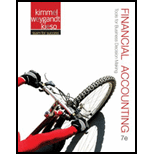
Concept explainers
(a)
Account:
An account refers to a financial record in the general ledger, where the increase or decrease in the values of the assets, liabilities, stockholder’s equity, revenues or expenditures of the business, pertaining to a particular period are recorded. Some of the accounts are assets, liabilities, and stockholder’s equity.
Assets:
Assets are the resources, owned by the company, that are used for the generation of income in the future. Assets are classified under four major heads which are as follows:
- Current assets
- Long-term investments
- Property, Plant and Equipment
- Intangible assets
Some of the examples of assets are equipment,
Liabilities:
Liabilities refer to the financial debts or obligations, which the company is owed to its creditors. The creditors have the claims over the assets of the company. Some of the examples of the liabilities are accounts payable, unearned revenue, and income tax payable.
Stockholder’s equity represents the capital contributed by the shareholders to its business and the revenues generated for the business. Stockholders’ equity is sometimes referred to as the net worth of the shareholders or stockholders. The two parts of stockholders’ equity are common stock and
Normal debit and credit balance:
The excess amount of debit side over the credit side is shown as the normal debit balance. The excess amount of credit side over the debit side is shown as the normal credit balance.
| Type of account | Normal balance |
| Assets account | Debit balance |
| Liabilities account | Credit balance |
| Expense account | Debit balance |
| Revenue account | Credit balance |
| Dividends account | Debit balance |
Table (1)
To indicate: whethereach of the following account is an asset, a liability, or a stockholder’s equity account and whether it would have a normal debit or credit balance.
(b)
To indicate: whethereach of the following account is an asset, a liability, or a stockholder’s equity account and whether it would have a normal debit or credit balance.
(c)
To indicate: whethereach of the following account is an asset, a liability, or a stockholder’s equity account and whether it would have a normal debit or credit balance.
(d)
To indicate: whethereach of the following account is an asset, a liability, or a stockholder’s equity account and whether it would have a normal debit or credit balance.
(e)
To indicate: whethereach of the following account is an asset, a liability, or a stockholder’s equity account and whether it would have a normal debit or credit balance.
Want to see the full answer?
Check out a sample textbook solution
Chapter 3 Solutions
Financial Accounting
- Astrid Electronics recorded overhead costs of $23,750 at an activity level of 5,000 direct labor hours and $14,250 at 3,000 direct labor hours. Records also indicate that overhead of $19,000 occurred at 4,000 direct labor hours. What is the total estimated cost for 4,000 direct labor hours using the high-low method to estimate the cost equation? a. $19,000 b. $10,540 c. $11,020 d. $10,800arrow_forwardCorrect Answerarrow_forwardDaniels Manufacturing Inc. sold its furniture division, resulting in a loss of $120,000. Assuming a tax rate of 25%, the loss on this disposal will be reported on the income statement at what amount?arrow_forward
- Ridge Co. sells skateboards. Each skateboard requires direct materials for $85, direct labor for $40, and variable overhead of $35. The company expects fixed overhead costs of $396,000 and fixed selling and administrative costs of $124,000 for the next year. It expects to produce and sell 9,200 skateboards in the next year. What will be the selling price per unit if Ridge uses a mark-up of 22% of the total cost?arrow_forwardPlease need answer the general accounting questionarrow_forwardAccounting problem with correctarrow_forward
- Principles of Accounting Volume 1AccountingISBN:9781947172685Author:OpenStaxPublisher:OpenStax College
 Intermediate Accounting: Reporting And AnalysisAccountingISBN:9781337788281Author:James M. Wahlen, Jefferson P. Jones, Donald PagachPublisher:Cengage Learning
Intermediate Accounting: Reporting And AnalysisAccountingISBN:9781337788281Author:James M. Wahlen, Jefferson P. Jones, Donald PagachPublisher:Cengage Learning College Accounting, Chapters 1-27AccountingISBN:9781337794756Author:HEINTZ, James A.Publisher:Cengage Learning,
College Accounting, Chapters 1-27AccountingISBN:9781337794756Author:HEINTZ, James A.Publisher:Cengage Learning,  Auditing: A Risk Based-Approach (MindTap Course L...AccountingISBN:9781337619455Author:Karla M Johnstone, Audrey A. Gramling, Larry E. RittenbergPublisher:Cengage Learning
Auditing: A Risk Based-Approach (MindTap Course L...AccountingISBN:9781337619455Author:Karla M Johnstone, Audrey A. Gramling, Larry E. RittenbergPublisher:Cengage Learning College Accounting (Book Only): A Career ApproachAccountingISBN:9781337280570Author:Scott, Cathy J.Publisher:South-Western College Pub
College Accounting (Book Only): A Career ApproachAccountingISBN:9781337280570Author:Scott, Cathy J.Publisher:South-Western College Pub




